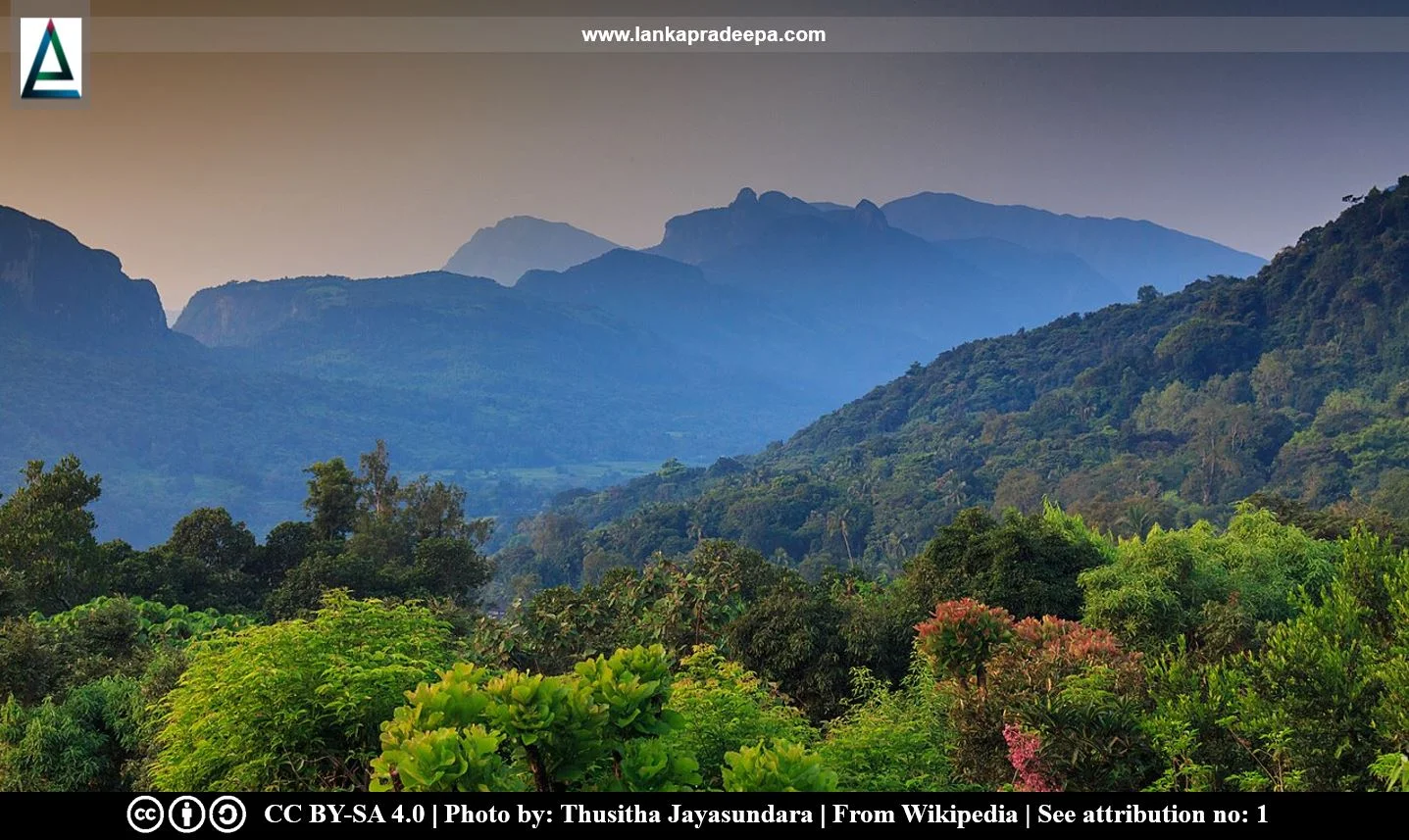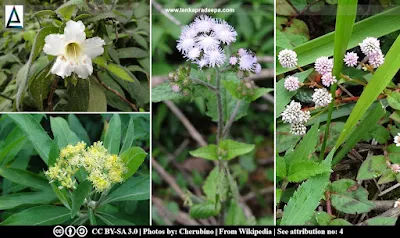
Knuckles Mountain Range (Sinhala: නකල්ස් කඳුවැටිය; Tamil: நக்கிள்ஸ் மலைத்தொடர்) is located in central Sri Lanka, in the districts of Matale and Kandy. It encompasses a land area of 21,000 ha within an altitude of 115-1,906 m in the Central Highlands of Sri Lanka which was declared a World Heritage Site in 2010 by UNESCO for its rich biodiversity (Karunaratne & Edirisinghe, 2009; Ranaweera & Jayarathna, 2013; Subasinghe et al., 2014; Weerakoon et al., 2010).
The mountain range takes its name from a series of recumbent folds and peaks (Perera et al., 2011). Whilst this name was assigned by early British surveyors, the Sinhalese residents have traditionally referred to the area as Dumbara Kanduvetiya meaning mist-laden mountain range (Perera et al., 2011).
Geology & characteristics
Situated in the Intermediate Zone of the island, the landscape of the Knuckles Mountain Range is considered unique (Karunaratne & Edirisinghe, 2009). Geologically the region forms part of Sri Lanka’s central massif, but it is isolated from the island's main mountain areas by the Dumbara Valley in the south and east, and by the Matale Valley in the west (Badenoch, 2009). The area's landscape is extremely rugged with more than 35
peaks rising above 300 m and the highest point reaches 1,863 m (Badenoch, 2009). The major forest formations of the landscape include montane (>1300 m), sub-montane (1300-600 m), semi-evergreen (<700 m) and extensive strips of riverine forests (Ranaweera & Jayarathna, 2013; Weerakoon et al., 2010).
Knuckles lies on the boundary between the wet and dry zones of Sri Lanka and has a variable climate (Badenoch, 2009). The eastern and northern parts of the mountain range are seasonally dry, while the upper parts have a montane ever-wet climate (Karunaratne & Edirisinghe, 2009). The annual rainfall in the wettest area is 2,725-4,470 mm while the mean annual temperature ranges between 25-27 °C at lower altitudes and 18-20 °C at higher altitudes (Karunaratne & Edirisinghe, 2009).
The Knuckles area constitutes 30% of the watershed forest of the Mahaweli Catchment, the major source of water for Sri Lanka’s agricultural sector (Badenoch, 2009).
Flora & Fauna
Many rare species of Flora & Fauna could be seen with rich ecosystems throughout the whole range of the Knuckles forest (Ranaweera & Jayarathna, 2013). Although the forest covers only about 0.3% of the country’s land area, it harbours over a third of the country’s flowering plants (Badenoch, 2009). Its floristic composition comprises 1,033 species of flowering plants of which 160 (15%) are endemic to Sri Lanka (Karunaratne & Edirisinghe, 2009). Of the 288 recorded woody plant species in the area, 85 are endemic, 11 are nationally threatened and 26 are globally threatened (Badenoch, 2009). In all some 31 mammal species, 128 birds, 53 reptiles, 20 amphibians and 25 freshwater fish have been recorded in the area (Badenoch, 2009)
Degradation
Economic trends have severely impacted The Knuckles Forest Reserve over the past several decades (Subasinghe et al., 2014). In the middle of the 20th century, some parts of the forest within the range were cleared to cultivate coffee and subsequently to grow tea (Subasinghe et al., 2014). As it was identified that the climatic condition of the Knuckles Range is suitable for cardamom plantation, the forest was cleared for under-planting of cardamom and this become a bigger threat to the forest range in 1960 when the government-authorized individuals and groups started to grow cardamom (Subasinghe et al., 2014). However, with the initiation of new reforestation policies in the 1960s a number of pinus plantations were established around the range (Subasinghe et al., 2014).
Conservation efforts
In 1873, the colonial British Government declared the areas over the height of 1,500 m in the mountain range as climatic reservations (Badenoch, 2009; Ranaweera & Jayarathna, 2013). In 1975 one of the peaks of the Knuckles range, Dotulugala, was declared a Man and Biosphere (MAB) Reserve (Badenoch, 2009). In 1988, after the formulation of Sri Lanka’s new National Forest Policy (1980), the Knuckles Conservation Area was declared over all lands above 1,067 m (Badenoch, 2009).
In 1994 the Sri Lankan government created a Management Plan for the Conservation of the Knuckles Forest and following that, the area was declared a National Man and Biosphere Reserve in 2000 and was given protected status as a Conservation Forest (Badenoch, 2009). In 2007 the forest was gazetted as the Knuckles Environment Protection Area, and Sri Lanka’s Central Environment Authority was given responsibility for enforcing all relevant environmental laws in the area (Badenoch, 2009).

.
Do you know?
Attribution
4) Knuckles Mountain Range plants 03, Knuckles Mountain Range plants 20, Knuckles Mountain Range plants 08 and Knuckles Mountain Range plants 09 by Cherubino are licensed under CC BY-SA 3.0
References
1) Badenoch, N., 2009. Improving Forest Governance in Knuckles: Dialogue and development for better outcomes. Gland, Switzerland and Bangkok, Thailand: IUCN. Revised edition, Gland, Switzerland and Bangkok, Thailand: IUCN. pp.1-15.
2) Karunaratne, W.A.I.P.; Edirisinghe, J.P., 2009. Diversity of bees at different altitudes in the Knuckles forest reserve. Ceylon Journal of Science (Biological Sciences), 37(1). pp.61-72.
3) Perera, D.H.A.S.S., Kamalrathne, T., Bandara, T.W.M.T.W. and Rasnayake, S., 2011. The role of eco-tourism on rural livelihood development: A case study of Riverston region in Knuckes range Sri Lanka. International Conference on Competency Building and Strategic Management for Sustainable Development, Sri Sai Ram Management Studies, Sri Sai Ram Engineering College, Tambaram.
4) Ranaweera, R.A. and Jayarathna, E.G., 2013. Relationship between Traditional Communities and Knuckles Reserve. p.185-186.
5) Subasinghe, K., Sumanapala, A.P. and Weerawardhena, S.R., 2014. The impact of forest conversion on bird communities in the northern flank of the Knuckles Mountain Forest Range, Sri Lanka. Journal of Asia-Pacific Biodiversity, 7(4), pp.367-373.
6) Weerakoon, G.S.K., Somaratne, S., Wolseley, P.A. and Wijeyaratne, S.C., 2010. Corticolous lichens as indicators of different forest management practices in the Dotalugala-Knuckles mountain range, Sri Lanka. In Proceedings of International Forestry and Environment Symposium (Vol. 15). pp.182-189.
Explore Other Nearby Attractions
Location Map (Google)
This page was last updated on 30 July 2023




